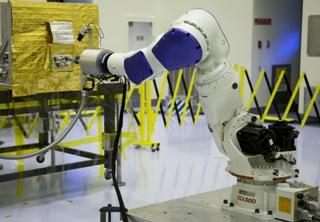
The RROxiTT industrial robot mimicked how future space robots could transfer oxidizer to a satellite valve. A NASA photo
WASHINGTON (PTI): NASA has successfully concluded a remotely controlled test of new technologies to empower future space robots to repair and refuel future satellites in space.
NASA is incorporating results from this test and the Robotic Refuelling Mission on the International Space Station (ISS) to prepare for an upcoming ground-based test of a full-sized robotic servicer system that will perform tasks on a mock satellite client.
These efforts are part of an ongoing and aggressive technology development campaign to equip robots and humans with the tools and capabilities needed for spacecraft maintenance and repair, the assembly of large space telescopes, and extended human exploration.
The Satellite Servicing Capabilities Office (SSCO) at NASA's Goddard Space Flight Centre in Greenbelt, checked another critical milestone off their list with the completion of their Remote Robotic Oxidiser Transfer Test (RROxiTT) in February, NASA said.
"This is the first time that anyone has tested this type of technology, and we've proven that it works. It's ready for the next step to flight," said Frank Cepollina, veteran leader of the five servicing missions to the Hubble Space Telescope and the associate director of SSCO.
"RROxiTT gives NASA, and the satellite community at large, confidence that advanced satellite refuelling and maintenance technologies aren't a wild dream of the future," said Cepollina.
Taking lessons learned from the successful Robotic Refuelling Mission, the SSCO team devised the ground-based RROxiTT to test how robots can transfer hazardous oxidiser, at flight-like pressures and flow rates, through the propellant valve and into the mock tank of a satellite.
While this capability could be applied to spacecraft in multiple orbits, SSCO focused RROxiTT specifically on technologies that could help satellites travelling the busy space highway of geosynchronous Earth orbit, or GEO.
Located about 35,406km above Earth, this orbital path is home to more than 400 satellites, many of which beam communications, television and weather data to customers worldwide.
By developing robotic capabilities to repair and refuel GEO satellites, NASA hopes to add precious years of functional life to satellites and expand options for operators who face unexpected emergencies, tougher economic demands and ageing fleets.
NASA also hopes that these new technologies will help boost the commercial satellite-servicing industry that is rapidly gaining momentum.
Besides aiding the GEO satellite community, a capability to fix and relocate "ailing" satellites also could help mitigate the growing orbital debris problem that threatens continued space operations, ultimately making space greener and more sustainable.
 Previous Article
Previous Article Next Article
Next Article













The Indian Air Force, in its flight trials evaluation report submitted before the Defence Ministry l..
view articleAn insight into the Medium Multi-Role Combat Aircraft competition...
view articleSky enthusiasts can now spot the International Space Station (ISS) commanded by Indian-American astr..
view article